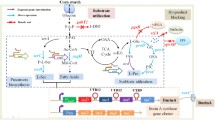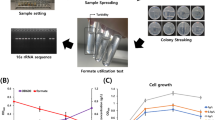Abstract
O-Acetyl-L-homoserine (OAH) is a potentially important platform metabolic intermediate for the production of homoserine lactone, methionine, 1,4-butanediol and 1,3-propanediol which have giant market value. Currently, multiple strategies have been adopted to explore sustainable production of OAH. However, the production of OAH by consuming cheap bio-based feedstocks with Escherichia coli as the chassis is still in its infancy. Construction of high yield OAH-producing strains is of great significance in industry. In this study, we introduced an exogenous metA from Bacillus cereus (metXbc) and engineered an OAH-producing strain by combinatorial metabolic engineering. Initially, exogenous metXs/metA were screened and used to reconstruct an initial biosynthesis pathway of OAH in E. coli. Subsequently, the disruption of degradation and competitive pathways combined with optimal expression of metXbc were carried out, accumulating 5.47 g/L OAH. Meanwhile, the homoserine pool was enriched by overexpressing metL with producing 7.42 g/L OAH. Lastly, the carbon flux of central carbon metabolism was redistributed to balance the metabolic flux of homoserine and acetyl coenzyme A (acetyl-CoA) in OAH biosynthesis with accumulating 8.29 g/L OAH. The engineered strain produced 24.33 g/L OAH with a yield of 0.23 g/g glucose in fed-batch fermentation. By these strategies, the key nodes for OAH synthesis were clarified and corresponding strategies were proposed. This study would lay a foundation for OAH bioproduction.





Similar content being viewed by others
Data availability
The data supporting this study's findings are available at the request of the corresponding author.
References
Calero P, Nikel PI (2019) Chasing bacterial chassis for metabolic engineering: a perspective review from classical to non-traditional microorganisms. Microb Biotechnol 12:98–124. https://doi.org/10.1111/1751-7915.13292
Goudarzi M, Born TL (2006) Purification and characterization of Thermotoga maritima homoserine transsuccinylase indicates it is a transacetylase. Extremophiles 10:469–478. https://doi.org/10.1007/s00792-006-0522-3
Hacham Y, Gophna U, Amir R (2003) In vivo analysis of various substrates utilized by cystathionine γ-synthase and O-acetylhomoserine sulthydrylase in methionine biosynthesis. Mol Biol Evol 20:1513–1520. https://doi.org/10.1093/molbev/msg169
Hang JF, Li HM, Deng L (2002) Development of a rapid, room-temperature dynamic kinetic resolution for efficient asymmetric synthesis of α-aryl amino acids. Org Lett 4:3321–3324. https://doi.org/10.1021/ol026660l
Hong KK, Kim JH, Yoon JH, Park HM, Choi SJ, Song GH, Lee JC, Yang YL, Shin HK, Kim JN, Cho KH, Lee JH (2014) O-Succinyl-L-homoserine-based C4-chemical production: succinic acid, homoserine lactone, γ-butyrolactone, γ-butyrolactone derivatives, and 1,4-butanediol. J Ind Microbiol Biotechnol 41:1517–1524. https://doi.org/10.1007/s10295-014-1499-z
Huang JF, Liu ZQ, Jin LQ, Tang XL, Shen ZY, Yin HH, Zheng YG (2017) Metabolic engineering of Escherichia coli for microbial production of L-methionine. Biotechnol Bioeng 114:843–851. https://doi.org/10.1002/bit.26198
Huang JF, Shen ZY, Mao QL, Zhang XM, Zhang B, Wu JS, Liu ZQ, Zheng YG (2018a) Systematic analysis of bottlenecks in a multibranched and multilevel regulated pathway: the molecular fundamentals of L-methionine biosynthesis in Escherichia coli. ACS Synth Biol 7:2577–2589. https://doi.org/10.1021/acssynbio.8b00249
Huang JF, Zhang B, Shen ZY, Liu ZQ, Zheng YG (2018) Metabolic engineering of E. coli for the production of O-succinyl-L-homoserine with high yield. 3 Biotech 8:310. https://doi.org/10.1007/s13205-018-1332-x
Jin LQ, Li ZT, Liu ZQ, Zheng YG, Shen YC (2014) Efficient production of methionine from 2-amino-4-methylthiobutanenitrile by recombinant Escherichia coli harboring nitrilase. J Ind Microbiol Biot 41:1479–1486. https://doi.org/10.1007/s10295-014-1490-8
Jin L, Nawab S, Xia M, Ma X, Huo YX (2019) Context-dependency of synthetic minimal promoters in driving gene expression: a case study. Microb Biotechnol 12:1476–1486. https://doi.org/10.1111/1751-7915.13489
Kase H, Nakayama K (1974) Production of O-acetyl-L-homoserme by methionine analogresistant mutants and. Regulation of homosenne-O-transacetylase in Gorynebacterium glutamicum. Agric Biol Chem 38:2021–2030. https://doi.org/10.1080/00021369.1974.10861451
Kim SY, Choi KM, Shin YU, Um HW, Choi KO, Chang JS, Cho YW, Park YH (2015) Microorganism producing L-methionine precursor and method of producing L-methionine and organic acid from the L-methionine precursor. US Patent US009029105B2,
Kwon YD, Kim S, Lee SY, Kim P (2011) Long-term continuous adaptation of Escherichia coli to high succinate stress and transcriptome analysis of the tolerant strain. J Biosci Bioeng 111:26–30. https://doi.org/10.1016/j.jbiosc.2010.08.007
Lee JH, Lee DE, Lee BU, Kim HS (2003) Global analyses of transcriptomes and proteomes of a parent strain and an L-threonine-overproducing mutant strain. J Bacteriol 185:5442–5451. https://doi.org/10.1128/jb.185.18.5442-5451.2003
Li YJ, Wei HB, Wang T, Xu QY, Zhang CL, Fan XG, Ma Q, Chen N, Xie XX (2017) Current status on metabolic engineering for the production of L-aspartate family amino acids and derivatives. Bioresour Technol 245:1588–1602. https://doi.org/10.1016/j.biortech.2017.05.145
Li B, Zhang B, Wang P, Cai X, Tang YQ, Jin JY, Liang JX, Liu ZQ, Zheng YG (2021) Targeting metabolic driving and minimization of by-products synthesis for high-yield production of D-pantothenate in Escherichia coli. Biotechnol J 17:e2100431. https://doi.org/10.1002/biot.202100431
Li N, Zeng WZ, Zhou JW, Xu S (2022) O-Acetyl-L-homoserine production enhanced by pathway strengthening and acetate supplementation in Corynebacterium glutamicum. Biotechnol Biofuels 15:27. https://doi.org/10.1186/s13068-022-02114-0
Liu P, Zhang B, Yao ZH, Liu ZQ, Zheng YG (2020) Multiplex design of the metabolic network for production of L-homoserine in Escherichia coli. Appl Environ Microb 86:e01477-e1420. https://doi.org/10.1128/AEM.01477-20
Liu N, Zhang TT, Rao ZM, Zhang WG, Xu JZ (2021) Reconstruction of the diaminopimelic acid pathway to promote L-lysine production in Corynebacterium glutamicum. Int J Mol Sci 22:9065. https://doi.org/10.3390/ijms22169065
Lu J, Tang J, Liu Y, Zhu X, Zhang T, Zhang X (2012) Combinatorial modulation of galP and glk gene expression for improved alternative glucose utilization. Appl Microbiol Biotechnol 93:2455–2462. https://doi.org/10.1007/s00253-011-3752-y
Mu Q, Zhang S, Mao X, Tao Y, Yu B (2021) Highly efficient production of L-homoserine in Escherichia coli by engineering a redox balance route. Metab Eng 67:321–329. https://doi.org/10.1016/j.ymben.2021.07.011
Nora LC, Wehrs M, Kim J, Cheng JF, Tarver A, Simmons BA, Magnuson J, Harmon-Smith M, Silva-Rocha R, Gladden JM, Mukhopadhyay A, Skerker JM, Kirby J (2019) A toolset of constitutive promoters for metabolic engineering of Rhodosporidium toruloides. Microb Cell Fact 18:117. https://doi.org/10.1186/s12934-019-1167-0
Ogawa-Miyata Y, Kojima H, Sano K (2001) Mutation analysis of the feedback inhibition site of aspartokinase III of Escherichia coli K-12 and its use in L-threonine production. Biosci Biotechnol Biochem 65:1149–1154. https://doi.org/10.1271/bbb.65.1149
Song CW, Lee J, Ko YS, Lee SY (2015) Metabolic engineering of Escherichia coli for the production of 3-aminopropionic acid. Metab Eng 30:121–129. https://doi.org/10.1016/j.ymben.2015.05.005
Walther T, Calvayrac F, Malbert Y, Alkim C, Dressaire C, Cordier H, Francois JM (2018) Construction of a synthetic metabolic pathway for the production of 2,4-dihydroxybutyric acid from homoserine. Metab Eng 45:237–245. https://doi.org/10.1016/j.ymben.2017.12.005
Wei L, Wang Q, Xu N, Cheng J, Zhou W, Han G, Jiang H, Liu J, Ma Y (2019) Combining protein and metabolic engineering strategies for high-level production of O-acetylhomoserine in Escherichia coli. ACS Synth Biol 8:1153–1167. https://doi.org/10.1021/acssynbio.9b00042
Wendisch VF (2020) Metabolic engineering advances and prospects for amino acid production. Metab Eng 58:17–34. https://doi.org/10.1016/j.ymben.2019.03.008
Xu JM, Li JQ, Zhang B, Liu ZQ, Zheng YG (2019) Fermentative production of the unnatural amino acid L-2-aminobutyric acid based on metabolic engineering. Microb Cell Fact 18:43. https://doi.org/10.1186/s12934-019-1095-z
Zhang B, Zhang XM, Wang W, Liu ZQ, Zheng YG (2019) Metabolic engineering of Escherichia coli for D-pantothenic acid production. Food Chem 294:267–275. https://doi.org/10.1016/j.foodchem.2019.05.044
Zhang B, Chen L, Jin JY, Zhong N, Cai X, Zou S-P, Zhou HY, Liu Z, Zheng YG (2021) Strengthening the (R)-pantoate pathway to produce D-pantothenic acid based on systematic metabolic analysis. Food Biosci 43:101283. https://doi.org/10.1016/j.fbio.2021.101283
Ziegler K, Noble SM, Mutumanje E, Bishop B, Huddler DP, Born TL (2007) Identification of catalytic cysteine, histidine, and lysine residues in Escherichia coli homoserine transsuccinylase. Biochemistry-Us 46:2674–2683. https://doi.org/10.1021/bi0620252
Zou X, Guo L, Huang L, Li M, Zhang S, Yang A, Zhang Y, Zhu L, Zhang H, Zhang J, Feng Z (2020) Pathway construction and metabolic engineering for fermentative production of β-alanine in Escherichia coli. Appl Microbiol Biotechnol 104:2545–2559. https://doi.org/10.1007/s00253-020-10359-8
Acknowledgements
We are grateful to Dr. Pil Kim from Department of Biotechnology, Catholic University for providing strain E. coli W3110 (DE3). We are also grateful to Dr. Sheng Yang from Institute of Plant Physiology and Ecology (Chinese Academy of Science, Shanghai) for providing CRISPR-Cas9 plasmids.
Funding
This research was supported by the National Key Research and Development Project of China (2018YFA0901400) and the National Natural Science Foundation of China (No. 31971342 and 31700095).
Author information
Authors and Affiliations
Contributions
YGZ and ZQL conceived of the study. BL wrote the manuscript and LGH, ZQL revised the manuscript. BL, YFY, YYC, XJZ performed the experiments and contributed to data analysis. All authors reviewed and approved the final manuscript.
Corresponding author
Ethics declarations
Conflict of interest
The authors declare that they have no conflict of interest in the publication.
Ethical approval
This article does not contain any studies with human participants or animals performed by any of the authors.
Supplementary Information
Below is the link to the electronic supplementary material.
Rights and permissions
Springer Nature or its licensor (e.g. a society or other partner) holds exclusive rights to this article under a publishing agreement with the author(s) or other rightsholder(s); author self-archiving of the accepted manuscript version of this article is solely governed by the terms of such publishing agreement and applicable law.
About this article
Cite this article
Li, B., Huang, LG., Yang, YF. et al. Metabolic engineering and pathway construction for O-acetyl-L-homoserine production in Escherichia coli. 3 Biotech 13, 173 (2023). https://doi.org/10.1007/s13205-023-03564-5
Received:
Accepted:
Published:
DOI: https://doi.org/10.1007/s13205-023-03564-5




